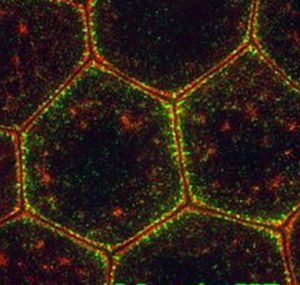Remodeling the zonula adherens in response to tension and the role of afadin in this response
Authors
Choi W, Acharya BR, Peyret G, Fardin MA, Mège RM, Ladoux B, Yap AS, Fanning AS, Peifer M.
Editors
J Cell Biol.
2016 Apr 12
Abstract
 Morphogenesis requires dynamic coordination between cell–cell adhesion and the cytoskeleton to allow cells to change shape and move without losing tissue integrity. We used genetic tools and superresolution microscopy in a simple model epithelial cell line to define how the molecular architecture of cell–cell zonula adherens (ZA) is modified in response to elevated contractility, and how these cells maintain tissue integrity. We previously found that depleting zonula occludens 1 (ZO-1) family proteins in MDCK cells induces a highly organized contractile actomyosin array at the ZA. We find that ZO knockdown elevates contractility via a Shroom3/Rho-associated, coiled-coil containing protein kinase (ROCK) pathway. Our data suggest that each bicellular border is an independent contractile unit, with actin cables anchored end-on to cadherin complexes at tricellular junctions. Cells respond to elevated contractility by increasing junctional afadin. Although ZO/afadin knockdown did not prevent contractile array assembly, it dramatically altered cell shape and barrier function in response to elevated contractility. We propose that afadin acts as a robust protein scaffold that maintains ZA architecture at tricellular junctions.
Morphogenesis requires dynamic coordination between cell–cell adhesion and the cytoskeleton to allow cells to change shape and move without losing tissue integrity. We used genetic tools and superresolution microscopy in a simple model epithelial cell line to define how the molecular architecture of cell–cell zonula adherens (ZA) is modified in response to elevated contractility, and how these cells maintain tissue integrity. We previously found that depleting zonula occludens 1 (ZO-1) family proteins in MDCK cells induces a highly organized contractile actomyosin array at the ZA. We find that ZO knockdown elevates contractility via a Shroom3/Rho-associated, coiled-coil containing protein kinase (ROCK) pathway. Our data suggest that each bicellular border is an independent contractile unit, with actin cables anchored end-on to cadherin complexes at tricellular junctions. Cells respond to elevated contractility by increasing junctional afadin. Although ZO/afadin knockdown did not prevent contractile array assembly, it dramatically altered cell shape and barrier function in response to elevated contractility. We propose that afadin acts as a robust protein scaffold that maintains ZA architecture at tricellular junctions.


